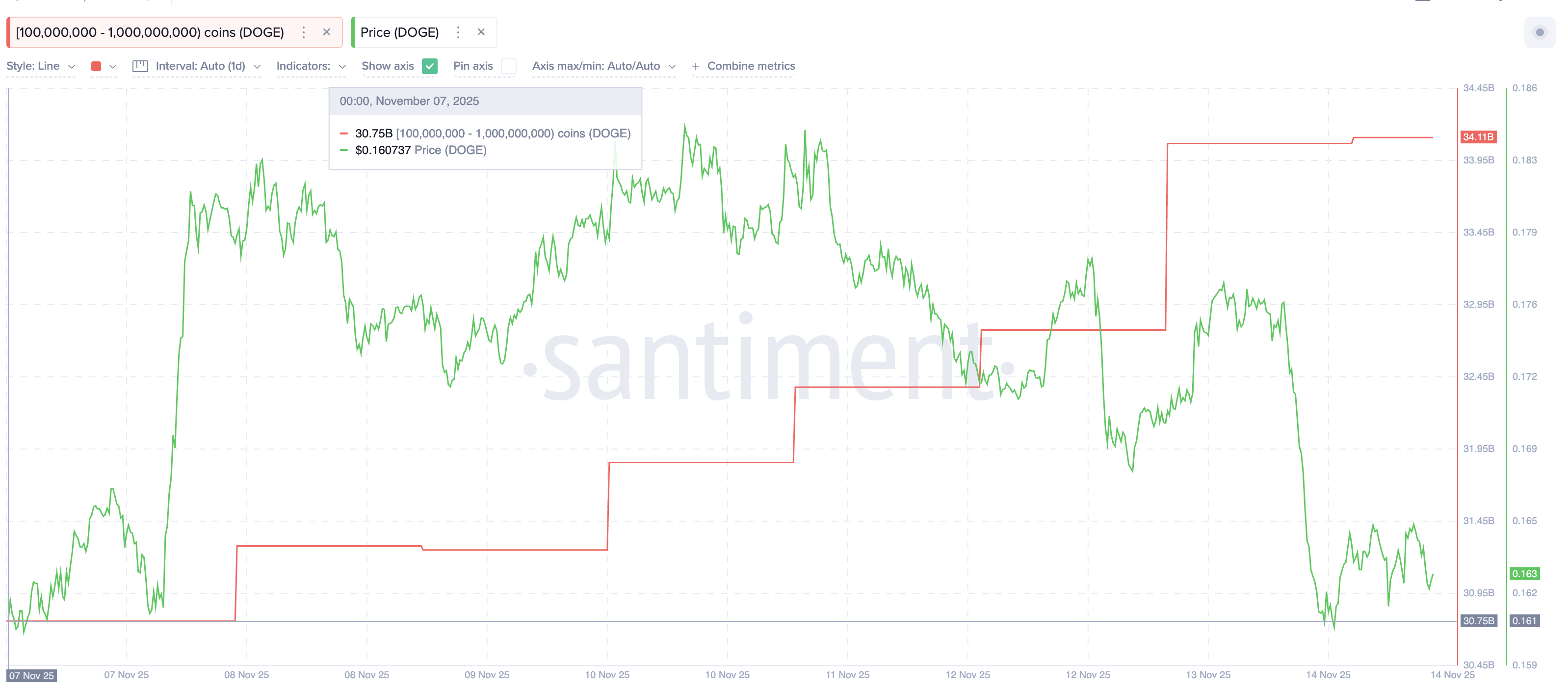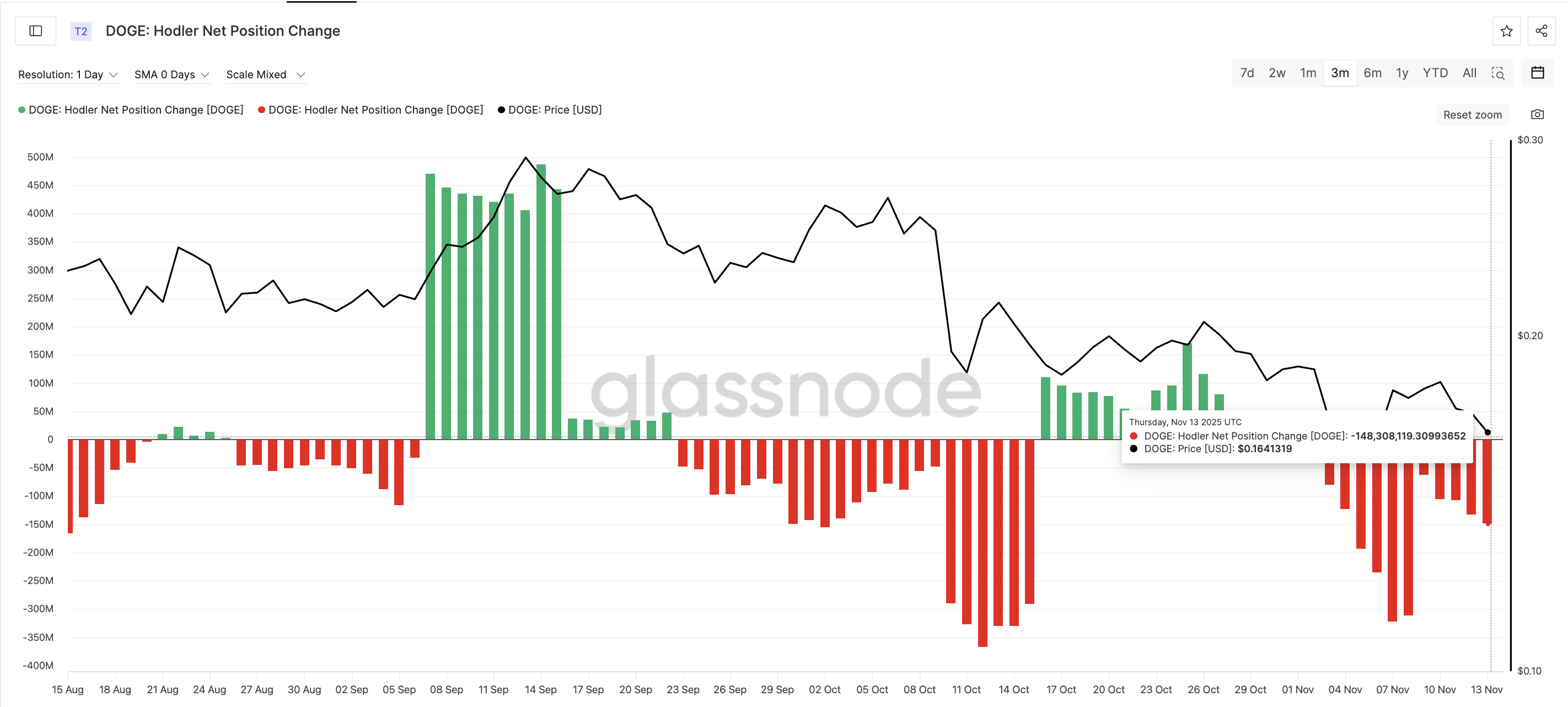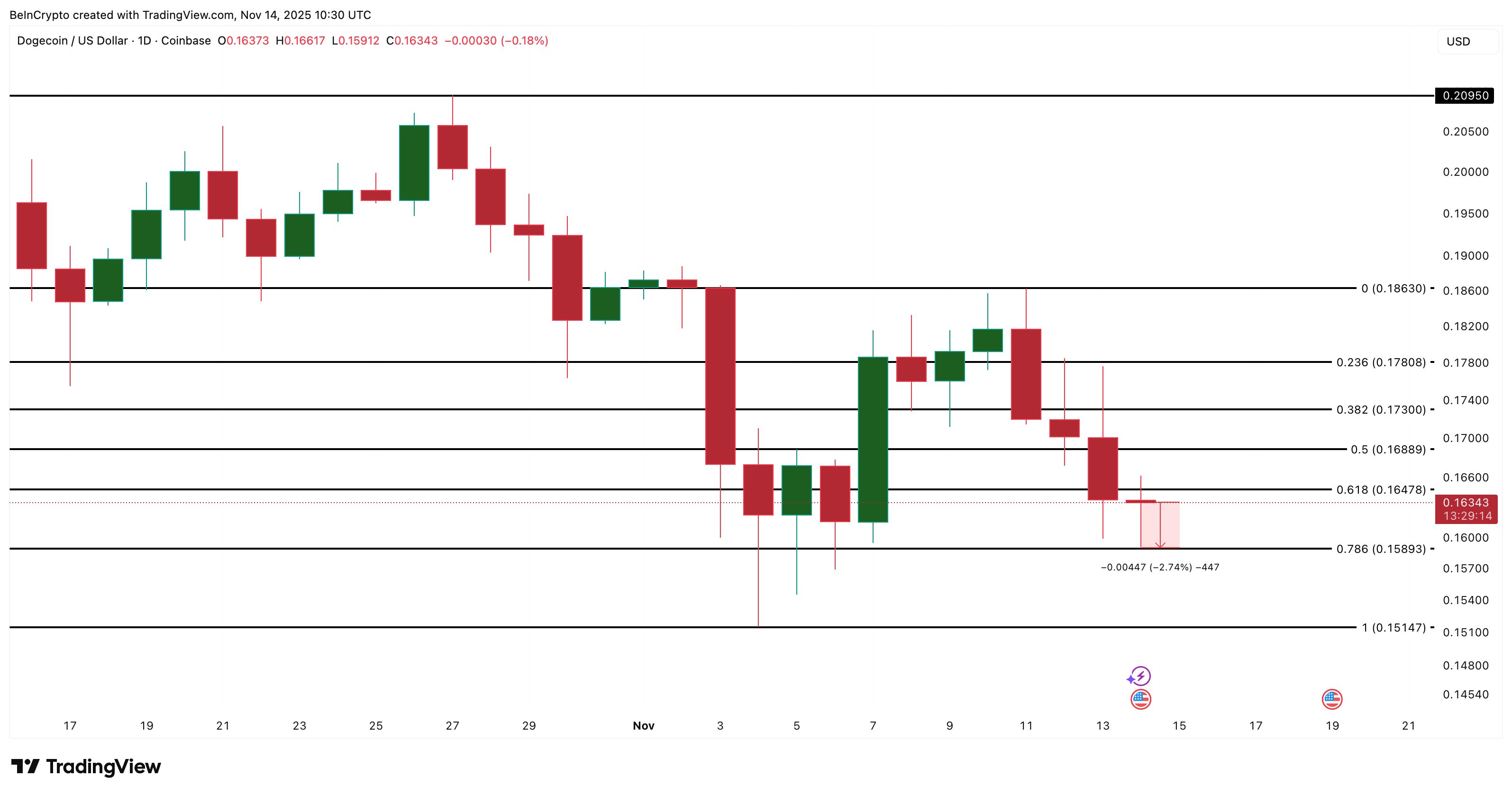Not ETF Buzz, Nor Whales — This Group Can Save Dogecoin (DOGE) Price From a Breakdown
Dogecoin price continues to fall even as whales accumulate and ETF anticipation builds. The only group that has historically triggered DOGE recoveries — long-term holders — is still selling heavily. With the price sitting below a key cost-basis cluster, the next move rests entirely on whether this group flips back to inflows.
Dogecoin is down about 1% over the past week and dropped another 7.3% in the last 24 hours, making it one of the weakest large-cap coins during the latest market dip. The ETF noise did not help either. The countdown for the Bitwise spot Dogecoin ETF began on November 7, but DOGE has barely moved since then.
Whales have been buying too, yet the price keeps sliding. The charts show that one group can stop Dogecoin from breaking down, and they have not returned yet.
Whales Buy and ETF Buzz Builds — But Price Still Drops
Buying from whale wallets holding 100 million to 1 billion DOGE has continued since November 7. On that day, their holdings were 30.75 billion DOGE. Now they hold 34.11 billion DOGE. They added around 3.36 billion DOGE in one week. At today’s price, that represents more than $550 million in accumulated value.
 Dogecoin Whales:
Dogecoin Whales:
Even with this level of buying, DOGE is still down 1% over the same period. The ETF countdown also had no effect. Price stayed flat while institutional interest increased.
Looks like Bitwise is doing the 8(a) move for their spot Dogecoin ETF, which basically means they plan on going effective in 20 days barring an intervention.
— Eric Balchunas (@EricBalchunas) November 6, 2025
When whales buy and the price does not respond, it usually means another force is stronger. That force is long-term holders.
This Hodler Group Has a History of Triggering Rallies and Bounces
The Hodler Net Position Change shows long-term wallets have been selling aggressively. This metric tracks whether long-term holders are adding (inflows) or removing (outflows) coins.
On November 9, long-term holders removed 62.3 million DOGE. As of November 13, that number has jumped to 148.3 million DOGE, leaving long-term wallets. That is a 138% increase in selling pressure in less than a week.
 Dogecoin Hodlers Need To Buy Again:
Dogecoin Hodlers Need To Buy Again:
This same group triggered earlier price reactions:
• Between September 6–7, the metric flipped from outflows to inflows, and DOGE jumped about 33% shortly after.
• Between October 15–16, the same shift produced a smaller bounce of around 5% after a few days.
These moves show a clear pattern: price strength usually returns when long-term holders stop selling and begin adding again. Right now, the signal remains deep in outflows. Until it flips again, DOGE cannot build a real recovery.
Dogecoin Price Nears Breakdown Zone — One Level Holds the Entire Structure
DOGE now trades near $0.163 and sits near its largest cost-basis support cluster. The cost-basis heatmap shows the strongest concentration of holders between $0.164 and $0.165. As long as this zone holds, DOGE can stay stable and attempt a bounce or two.
 Cost Basis Heatmap To Identify Supply Zones:
Cost Basis Heatmap To Identify Supply Zones:
If DOGE closes a daily candle below $0.164 (which is currently possible), it will slip under this cluster. With almost no heavy support levels beneath it, the price can drop quickly. The next key level is $0.158, only 2.6% lower. A breakdown there exposes $0.151 and deeper losses if the market stays weak.
 Dogecoin Price Analysis:
Dogecoin Price Analysis:
On the upside, the DOGE price needs a move above $0.178 to show early strength. A stronger short-term reversal needs a clean break above $0.186. But neither move can hold unless long-term holders return and shift back to inflows.
Disclaimer: The content of this article solely reflects the author's opinion and does not represent the platform in any capacity. This article is not intended to serve as a reference for making investment decisions.
You may also like
Panic Rising, Miners Buying: Is Bitcoin Near Its Breaking Point?
Crypto Airdrops' Growing Centralization Threatens the Principles of Decentralized Fairness
- aPriori's crypto airdrop sparked controversy after one entity claimed 60% of tokens, raising transparency and centralization concerns. - Airdrop farming tactics, like Arbitrum's $3. 3M consolidation across 1,496 wallets, undermine decentralized fairness for retail investors. - HTX DAO's 90% growth in token subscriptions ($9B total) highlights deflationary strategies boosting scarcity and market value. - IPO market volatility and regulatory risks have pushed projects toward airdrops for liquidity, despite

Bitcoin News Today: Bitcoin ETFs Offload $2.96 Billion in November, Exceeding Mt. Gox Repayment Amounts
- Bitcoin ETFs sold $2.96B in November, exceeding Mt. Gox's $953M debt repayment transfers, signaling extreme bearish sentiment. - BlackRock's IBIT led outflows with $2.1B, including a $523M single-day withdrawal, as BTC prices fell 28% below $90,000. - Market analysts warn ETF redemptions could accelerate Bitcoin's decline, citing technical indicators like the "death cross" and weak institutional sentiment. - The sell-off contrasts Bitcoin's historical November rallies, driven by macroeconomic fears and A

Bitcoin Updates Today: Institutions Show Faith as Retail Investors Withdraw—Bitcoin Faces a Critical Year-End Challenge
- Bitcoin stabilizes above $90,000 amid retail selling and institutional hedging as year-end volatility risks grow. - U.S. spot Bitcoin ETFs face $2.6B outflows as investors shift to cash/bonds post-government shutdown. - Harvard boosts $443M IBIT stake while Wisconsin liquidates its position, highlighting institutional divergence. - Market indicators show 50% odds BTC closes 2025 below $90K, with $98K and $85K key support levels identified. - Whale accumulation of 375,000 BTC contrasts with retail capitul

